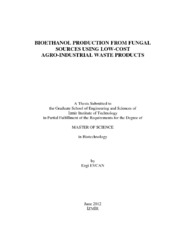Please use this identifier to cite or link to this item:
https://hdl.handle.net/11147/3481Full metadata record
| DC Field | Value | Language |
|---|---|---|
| dc.contributor.advisor | Tarı, Canan | - |
| dc.contributor.advisor | Özen, Fatma Banu | - |
| dc.contributor.author | Evcan, Ezgi | - |
| dc.date.accessioned | 2014-07-22T13:51:38Z | - |
| dc.date.available | 2014-07-22T13:51:38Z | - |
| dc.date.issued | 2012 | - |
| dc.identifier.uri | http://hdl.handle.net/11147/3481 | - |
| dc.description | Thesis (Master)--Izmir Institute of Technology, Biotechnology, Izmir, 2012. | en_US |
| dc.description | Includes bibliographical references (leaves: 76-80) | en_US |
| dc.description | Text in English; Abstract: Turkish and English | en_US |
| dc.description | xii, 85 leaves | en_US |
| dc.description.abstract | In recent years, the rapid increase in environmental problems, greenhouse gas emissions, fuel prices and the unlimited consumption of fuel stocks made people search for some alternative energy sources. Bioethanol is one of the most popular alternative sources with its many beneficial features. Considering the sugar content of fruit pomaces, which are the waste of fruit juice industry, are very convenient and cheap fermentation raw materials for production of bioethanol. The aim of this study was to create a renewable alternative for fossil fuel and to provide a viable solution to multiple environmental problems simultaneously creating a sink for waste utilization and optimize bioethanol production from apple pomace hydrolysate using Trichoderma harzianum, Aspergillus sojae and Saccharomyces cerevisiae by statistical methods. Here, screening and optimization steps were conducted in order to determine the significant factors and their optimum levels. Factors such as inoculation rate of A.sojae and T.harzianum and agitation speed were considered as factor variables, whereas the response variable was bioethanol production. According to the results of the screening process, inoculation rate of S.cerevisiae was fixed as 4% and aeration method as vented. In the optimization step, levels of the other factors were enlarged. The highest bioethanol production and yield on substrate were 8.748 g/l and 0.946, respectively. Higher concentrations of inoculation rates of T.harzianum and A.sojae (6%) and agitation speed of 200 rpm led to maximum bioethanol production. Furthermore, the results pointed out that using cocultures because of its synergistic interactions is an effective way for production of bioethanol. | en_US |
| dc.language.iso | en | en_US |
| dc.publisher | Izmir Institute of Technology | en_US |
| dc.rights | info:eu-repo/semantics/openAccess | en_US |
| dc.subject.lcsh | Agricultural wastes as fuel | en |
| dc.subject.lcsh | Fermentation | en |
| dc.subject.lcsh | Alcohol as fuel | en |
| dc.title | Bioethanol Production From Fungal Sources Using Low-Cost Agro-Industrial Waste Products | en_US |
| dc.type | Master Thesis | en_US |
| dc.institutionauthor | Evcan, Ezgi | - |
| dc.department | Thesis (Master)--İzmir Institute of Technology, Bioengineering | en_US |
| dc.relation.publicationcategory | Tez | en_US |
| dc.identifier.wosquality | N/A | - |
| dc.identifier.scopusquality | N/A | - |
| item.openairecristype | http://purl.org/coar/resource_type/c_18cf | - |
| item.languageiso639-1 | en | - |
| item.openairetype | Master Thesis | - |
| item.grantfulltext | open | - |
| item.fulltext | With Fulltext | - |
| item.cerifentitytype | Publications | - |
| crisitem.author.dept | 03.08. Department of Food Engineering | - |
| Appears in Collections: | Master Degree / Yüksek Lisans Tezleri | |
Files in This Item:
| File | Description | Size | Format | |
|---|---|---|---|---|
| T001019.pdf | MasterThesis | 2.16 MB | Adobe PDF |  View/Open |
CORE Recommender
Page view(s)
346
checked on Mar 31, 2025
Download(s)
176
checked on Mar 31, 2025
Google ScholarTM
Check
Items in GCRIS Repository are protected by copyright, with all rights reserved, unless otherwise indicated.